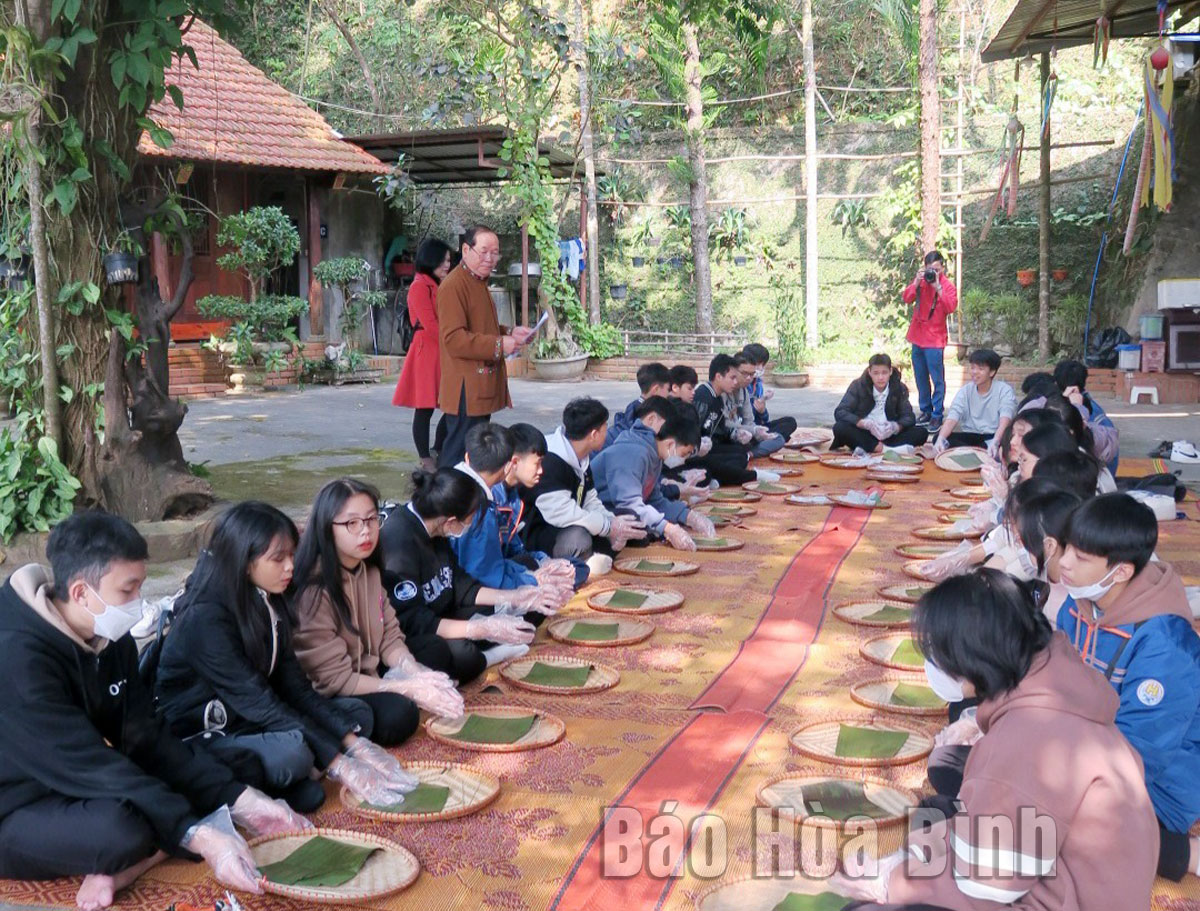
(HBO) – The Muong Cultural Heritage Museum, located in Thai Binh ward of Hoa Binh city (Hoa Binh province), is managed by Meritorious Artisan Bui Thanh Binh. Covering more than 4,000 sq.m., it features six main stilt houses displaying nearly 6,000 objects arranged according to different periods of the Muong ethnic group’s culture. The museum has become an attractive destination for Vietnamese and foreign visitors over the past years.
Meritorious Artisan Bui Thanh Binh, Director of the Muong Cultural Heritage Museum, shows students from the Hoang Van Thu High School for the Gifted how to make "banh uoi”, a traditional dish of the Muong people.
Binh said the Muong Cultural Heritage Museum, opened in 2014, is the second non-public in Hoa Binh province and the 24th private in Vietnam. It came as a result of his over-30-year efforts to collect antiquities of the Muong ethnic group from across Vietnam.
With six main stilt houses each of which has a different function, the museum meets diverse demand for exhibiting objects and performing arts of the ethnic minority. It showcases not only the items used in the daily life such as working tools, traditional costumes, and musical instruments, but also rare antiquities like bronze drums, gongs, and ceramics dating back thousands of years. Notably, the exhibits include a collection of more than 100 Muong gongs.
To bring the Muong cultural values closer to the public, Binh has been working hard to reform exhibition methods and activities of the museum. He has made museum presentation more interesting while holding a wide range of activities, including opening an outdoor area for displaying folk toys; organising folk games like "nem con”, "danh mang”, walking on stilts, and pole pushing; and instructing visitors in cooking traditional dishes of Muong people.
As head of the Muong village in the Hanoi-based Vietnamese National Village for Culture and Tourism, he has also been striving to spread the values of the Muong people’s culture far and wide.
In particular, Binh has directly taught how to play the Muong gongs to natives of Hoa Binh province such as the districts of Kim Boi, Tan Lac, and Lac Son, and Hoa Binh City. He has also been invited to teach the playing in other localities, including Hoa Thang commune of Buon Ma Thuot city, Dak Lak province; and Quoc Oai, Thach That, and Ba Vi districts of Hanoi. With his enthusiasm, he has inspired the interest in the traditional cultural heritage among generations of learners.
Binh has also assisted with Hoa Binh artisans’ reenactment and performance of Muong people’s festivals and epics on the rice culture at an event held in Bangkok; the exhibition of the Muong cultural heritage in the Vietnamese National Village for Culture and Tourism; and programmes introducing the ethnic group’s traditional music and cuisine in many provinces like Thai Nguyen, Quang Ninh, Lao Cai, Phu Tho, and Son La.
Thanks to those efforts, the Muong Cultural Heritage Museum has become a place for preserving the essence of the Muong culture and also an attractive destination for visitors once setting foot in Hoa Binh province./.
With an increasingly vibrant and widespread emulation movement aimed at building cultured residential areas and cultured families, Yen Thuy District has been making steady progress toward improving both the material and spiritual well-being of its people, while fostering a civilized, prosperous, beautiful, and progressive community.
Once lacking recreational spaces and community facilities, Residential Group 2 in Quynh Lam Ward (Hoa Binh City) has recently received attention for the construction of a new, spacious, and fully equipped cultural house. The project followed the model of state support combined with public contributions in both labor and funding.
The "All people unite to build cultural life" movement, which has been effectively integrated with Kim Boi district’s socio-economic development goals, is fostering a lively spirit of emulation across local residential areas, hamlets, villages, public agencies, and enterprises. In addition, through the initiative, traditional cultural values are being preserved and promoted, while community solidarity and mutual support in poverty reduction and economic development are being strengthened.
A working delegation of the Hoa Binh provincial People’s Committee led by its Permanent Vice Chairman Nguyen Van Toan on June 11 inspected the progress of a project to build the Mo Muong Cultural Heritage Conservation Space linked to tourism services in Hop Phong commune, Cao Phong district.
Born and growing in the heroic land of Muong Dong, Dinh Thi Kieu Dung, a resident in Bo town of Kim Boi district, in her childhood was nurtured by the sweet lullabies of her grandmother and mother. These melodies deeply imprinted on her soul, becoming an inseparable part of her love for her ethnic group's culture. For over 20 years, this love for her hometown has driven Dung to research, collect, and pass down the cultural values of the Muong people to future generations.
In the final days of May, the Ethnic Art Troupe of Hoa Binh Province organized performances to serve the people in remote, mountainous, and particularly disadvantaged areas within the province. These were not just ordinary artistic shows, but they were the meaningful journeys aimed at spreading cultural values, enhancing the spiritual life of the people and contributing to the preservation of ethnic minority cultural identities.



